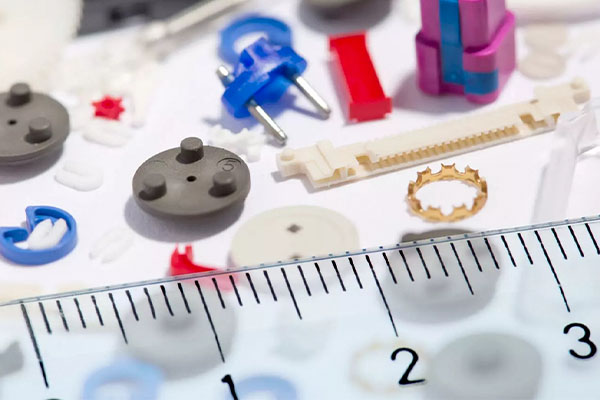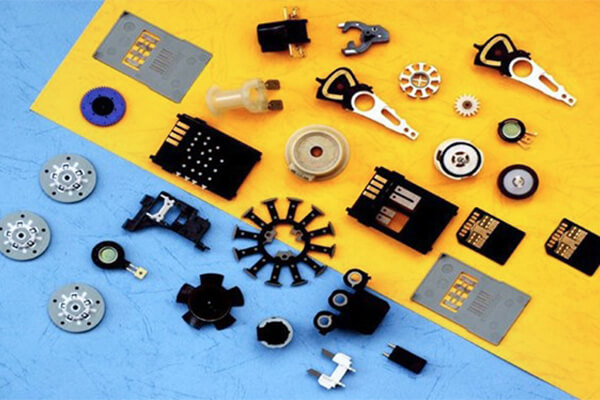Micro Injection Molding: Precise Complex Parts Manufacturing
Precise parts and complex plastic components are in high demand in the plastics production industry. Many engineers and product designers are using micro injection molding, a cutting-edge manufacturing method, to satisfy this demand. Small plastic components with a diameter of just a few millimeters might not be appropriate for production using traditional injection molding techniques.
Micro molding produces tiny objects with fine features, thin walls, micro holes, and strict tolerances, in contrast to traditional molding techniques. It guarantees scalability for high-volume production while empowering manufacturers to satisfy the demands for precise, tiny components.
We shall define micro injection molding and look at how it varies from the conventional molding process in this extensive guide. We shall also talk about its advantages and difficulties.

What is Micro Injection Molding?
Micro injection molding stands as a highly specialized subset of injection molding dedicated to the production of exceptionally small components. This intricate process revolves around crafting a cavity that mirrors the desired shape of the part. Employing micro-structured steel molds, precision is achieved through CNC and EDM techniques, ensuring tolerances at the micron or even submicron scale. This methodology facilitates the manufacture of components weighing less than a gram and possessing dimensions within the range of a few millimeters.

Principles of Micro Molding
The initiation of the micro molding process involves the preparation of a mold or tooling containing small cavities molded to the specifications of the desired component. In the liquid injection molding (LIM) process, liquid silicone rubber (LSR) is swiftly injected into the heated cavity, undergoing vulcanization to form the final part. Certain micro-molding techniques incorporate runners—channels guiding the material into cavities—while direct gating methods inject material directly into the part, eliminating runners and minimizing material waste.
Three crucial aspects characterize micro molding. Firstly, “micro” pertains to the part size itself, emphasizing small-scale manufacturing. Secondly, “microfeatures” denote tiny parts within a larger component, with specific components or features considered micro-sized. Lastly, “micro tolerance” underscores the precision and accuracy required in part measurements, demanding adherence to strict injection molding tolerances, sometimes as small as a thousandth of an inch.
The successful production of molded parts with micron tolerances hinges on factors such as tooling, mold design, and fabrication. Access to cutting-edge machining capabilities and seasoned professionals capable of achieving sub-micron tooling precision is imperative. Advanced metrology techniques are also deployed to validate the capabilities of molded components and automated sub-assemblies.
A pivotal factor influencing the utilization of micro injection molding is “micro tolerance,” denoting the slender margin of error permitted in part measurements. Tolerances can be as tight as 1/100th of an inch and, in some instances, as minute as 1/1000th of an inch. Conversely, small pieces not requiring such stringent tolerances can often be produced using traditional injection molding methods.
Micro Molding vs Conventional Injection Molding
While sharing similarities with traditional injection molding, micro molding exhibits distinctive characteristics. Micromolding necessitates the incorporation of a specialized injection unit tailored to accommodate the diminutive size of the components. The primary variance lies in the shot size and precision of the injection machines.
Micro-molding machines feature higher-resolution feed options, enabling the injection of minuscule fractions of a gram with exceptional precision. This capability ensures uniform pressure distribution within the cavity. Additionally, through the use of precision CNC and EDM tools, micro molds are meticulously machined, featuring smaller cores, cavities, and intricate features.
Another fundamental contrast between this advanced molding process and plastic injection molding pertains to the size of the produced pieces. The former employs molds crafted with higher precision processes, resulting in enhanced accuracy and repeatability. In contrast, the latter is more suited for larger parts and products, while micro molding excels in the production of small, highly precise components.
Furthermore, the materials utilized differ between the two methods. Micro injection molding often employs high-performance polymers such as liquid crystal polymers, renowned for their high-temperature resistance and exceptional mechanical properties. In contrast, plastic injection molding encompasses a broader range of materials, including elastomers, thermoplastics, and thermosets.
Advantages of Micro Injection Molding
Micro injection molding offers several benefits in terms of precision, machining, and cost-effectiveness. Among the numerous advantages of this technique, the following are particularly noteworthy:
Precision and Complexity
The advanced nature of micro injection molding excels in achieving high precision and intricate geometries. The process allows for the production of extremely small and detailed components with tight tolerances. Utilizing advanced machining techniques like CNC and EDM enables the creation of micro-sized cores, cavities, and features with exceptional accuracy. This precision is crucial, especially in industries such as medical devices, electronics, and micro-optics, where even minor deviations can significantly impact performance.
Material Selection and Compatibility
Micro injection molding supports various material options, including high-performance polymers and engineered thermoplastics. These materials offer excellent mechanical properties, chemical resistance, and thermal stability. The versatility in material selection allows for the manufacturing of components tailored to specific applications, optimizing properties like biocompatibility, electrical conductivity, and heat resistance.
Cost-Effectiveness and Efficiency
Unlike conventional injection molding, micro injection molding provides significant cost advantages. The smaller and more affordable tools required result in cost savings, with approximately 40% lower tooling costs compared to full-scale molding. Reduced clamping force requirements enable the use of smaller and less expensive machines. The process also reduces production costs through shorter cycle times, as micro molds, often made from aluminum, allow faster and more cost-effective machining. Compact barrels, fewer mold cavities, and smaller runners further contribute to cost reduction.
Integration of Multiple Steps
Micro injection molding can integrate multiple steps, such as assembly or overmolding, into a single production cycle. This consolidation of processes enhances efficiency and reduces overall manufacturing time. Optimized micro injection molding tooling and automation capabilities enable faster cycle times, improving productivity and overall cost-effectiveness. The small size of micro components also facilitates efficient material use, minimizing waste.
Micro injection molding stands as a versatile and efficient manufacturing process with distinct advantages, making it well-suited for applications requiring precision and small-scale production.
Applications of Micro Molding
Micro injection molding finds utility across a diverse spectrum of applications, particularly in scenarios where size and precision are paramount. Its capacity to manufacture small, intricate plastic parts with exceptional accuracy contributes to transformative developments in various industries:
Medical and Healthcare Industry
The healthcare sector, with its stringent precision requirements, benefits significantly from micro molding. This advanced process plays a crucial role in producing various medical devices, including drug delivery devices, diagnostic systems, catheters, and components for optical and hearing aids. Its suitability for instruments used in minimally invasive surgical procedures, such as neurosurgeries and aortic treatments, underscores its importance. The rising use of microfluidic systems in medical applications further drives the adoption of micro molding in the healthcare industry.
Electronics and Electrical Industry
In an era where electronic devices are continually shrinking, the electronics industry demands heightened precision. Micro injection molding proves advantageous in manufacturing a range of electronic components, including micro-optics for laser-based devices, smartphones, lenses, and prisms. It is also employed in crafting microelectronic components such as connectors, plugs, switches, and computer chips, catering to applications in computing, communication technology, and musical equipment.
Additionally, microelectromechanical systems (MEMS) rely on micro-molding techniques, witnessing increased demand in advanced manufacturing processes. Applications like Biomedical Micro-Electro-Mechanical Systems and the implementation of Next Generation Sequencing contribute to the growing demand for micro injection molding in MEMS.
Automotive and Aerospace Industry
The significance of micro injection molding is evident in the manufacturing of automotive components, where the need for lightweight and compact designs is frequent. It plays a role in producing various parts for automobiles, including engine components, brakes, and other relevant elements such as washers, clips, door locking mechanisms, switches, buttons, and microplastic gears. The versatility of micro molding addresses the intricate requirements of the automotive and aerospace sectors, contributing to advancements in design and functionality.
Challenges and Considerations in Micro Molding
Micro injection molding introduces distinctive challenges, ranging from meticulous tooling and material flow control to rigorous quality assurance and considerations for scalable production. Let’s delve into some of these challenges:
Tooling and Mold Design Complexity
Attaining exceptional accuracy and precision is pivotal in both mold construction and the production of micro parts. Even minor misalignments during injection molding design can significantly affect the quality of small-sized plastic parts. In micro-molding with liquid silicone rubber, additional precision is required in material mixing, color incorporation, and precise dosing to ensure process stability and repeatability.
Mold construction presents engineering challenges, particularly in mold design. Elements must be incorporated to ensure consistent alignment of mold halves, enabling precise demolding. The design should also ensure consistent quality and longevity, as micro injection molds are expected to produce millions of parts over their lifespan.
Material Flow and Injection Molding Parameters
Achieving proper material flow is critical due to the small size of mold cavities and thin walls of micro parts. Careful consideration of factors such as injection speed, pressure, temperature, and gate design is essential for uniform and consistent material flow.
Balanced cavity pressures in micro injection molds are vital for consistent filling. Good valve gate technology and a well-balanced cold deck prevent issues like short shots or incomplete filling. Cavity temperature influences material curing and part formation, and proper nozzle cooling aids the transition from cooling during filling to heating during vulcanization.
Direct gating is ideal with sufficient space for a gate; otherwise, alternative gating methods like film, edge, or tunnel gates are employed. Overflows ensure complete part filling and reduce the risk of trapped air. Runners contribute to efficient handling operations such as slitting, marking, printing, packaging, and assembly.
Quality Control and Inspection for Micro-Sized Components
The diminutive dimensions of micro-sized components pose challenges in visually inspecting parts for defects or dimensional accuracy. Non-destructive testing techniques, including high-resolution imaging systems or advanced metrology equipment, are necessary to detect and measure micro-level defects.
Implementation of strict quality control measures, including process monitoring and statistical analysis, is crucial to maintaining consistent quality throughout production.
Scalability and Production Volume Considerations
While micro injection molding is well-suited for small-scale production of micro-sized components, scaling up production presents challenges. Material selection and raw material availability in sufficient quantities can impact scalability. Designers and engineers must carefully assess cycle time, mold durability, and machine capacity to ensure efficient and cost-effective production at larger volumes.
Precision Injection Molding Service At Sungplastic
Although traditional injection molding has advantages, there are situations in which it is not appropriate. As a result, micro injection molding—a more accurate and condensed solution—has emerged. Its many benefits and wide range of uses make it a crucial component of many different sectors, successfully meeting emerging market difficulties.
Precision mold tooling, cutting-edge technologies, and efficient manufacturing procedures are essential for success in micro injection molding. Sungplastic is a trustworthy partner that provides full injection molding services, using state-of-the-art technology to realize your idea. Our team of highly qualified and experienced engineers gives you confidence and makes sure you get the best production solutions possible for your project.
Get in touch with us right now to start working on your micro molding projects using Sungplastic. Let’s collaborate together to turn the ideas to a reality.
Get a free quote and design analysis today.
We’ll reply to you within 6 working hours.
We respect your privacy.
+86 139 2927 4777 (WhatsApp, Wechat)
